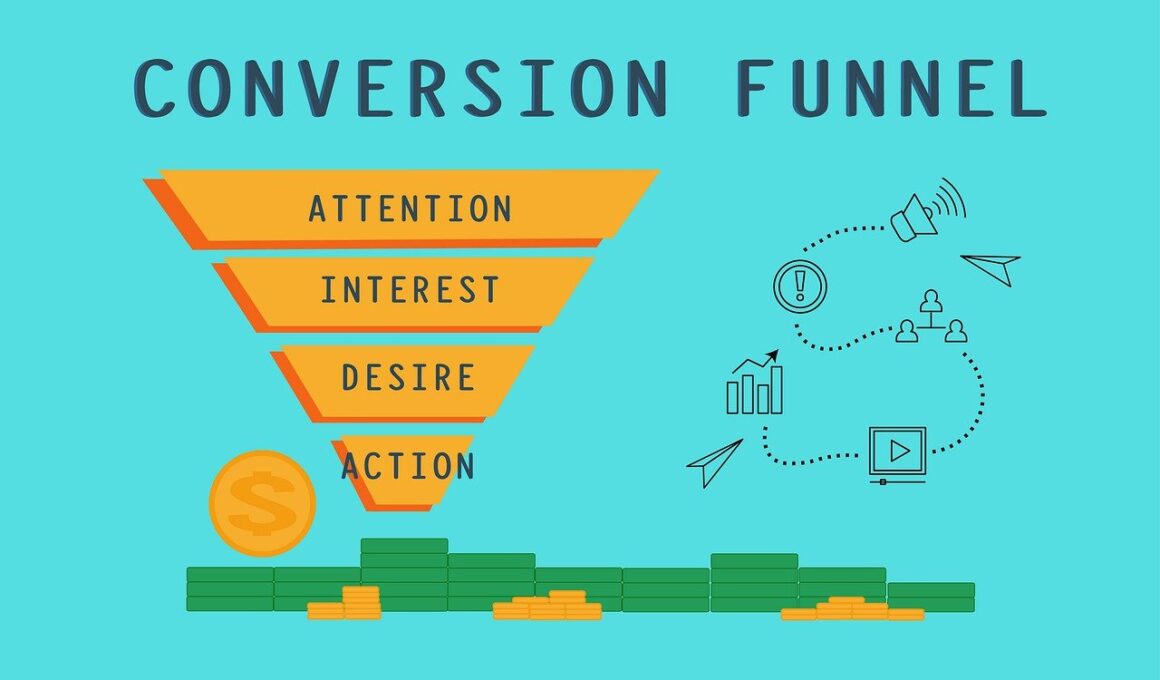Measuring Sales Funnel Performance: Key Metrics to Track
Understanding the sales funnel is crucial for businesses aiming for growth and sustainability. The sales funnel represents the journey potential customers take from awareness to purchase. By measuring funnel performance, businesses can identify areas for improvement and optimize conversions. Key metrics help assess the effectiveness of each funnel stage. For instance, tracking conversion rates at every stage helps determine where prospects drop off. Other essential metrics include customer acquisition cost, average deal size, and sales cycle length. Analyzing these metrics provides insights into sales strategies and budgets. Understanding how long it takes for leads to move through the funnel informs timely and effective follow-ups. Moreover, evaluating the customer lifetime value relative to acquisition costs helps determine long-term profitability. These metrics are instrumental in aligning marketing initiatives with sales goals. Every business needs a clear plan to track the effectiveness of their efforts consistently. By leveraging data and analytics, organizations can create a feedback loop that continuously improves their sales funnel performance, thereby enhancing overall business performance and achieving sustainable revenue growth.
Key Metrics to Monitor
To gauge the performance of your sales funnel, several key metrics warrant attention. First, the overall conversion rate, which indicates the percentage of leads that become customers, is critical for measuring success. Understanding this ratio quantifies the effectiveness of your sales process. Additionally, the drop-off rate at each funnel stage reveals bottlenecks in the process. Notably, if many leads fail to progress from awareness to consideration, marketing tactics may need revisiting. Metrics like lead source performance can also guide strategies. By identifying which channels produce the most valuable leads, you can allocate resources and budget effectively. Another important metric is the time spent at each funnel stage; insights here can help streamline processes. Regularly assessing sales pipeline velocity provides a view of how efficiently leads are converted into sales over time. Coupled with the average deal size, these evaluations form a comprehensive performance picture. Lastly, tracking customer satisfaction through surveys can add qualitative insights to quantitative metrics, ultimately leading to an improved strategy that nurtures prospects thoroughly throughout their purchasing journey.
Sales funnel management also involves monitoring the impact of various marketing campaigns on conversion rates. Measuring the return on investment (ROI) of these campaigns helps gauge their effectiveness and allocate budgets strategically. By identifying which marketing efforts fuel the most conversions, you can optimize spending to funnel more resources into high-performing avenues. This approach not only maximizes campaign success but also refines audience targeting. Another crucial aspect is the segmentation of leads based on specific criteria, such as demographics or behaviors. This segmentation allows for tailored marketing messages that resonate better with potential customers, enhancing engagement. Furthermore, using lead scoring models enables prioritizing high-potential leads based on their likelihood to convert. This method ensures the sales team focuses on leads that are closer to purchasing. It’s essential to review the funnel regularly, adjusting strategies based on what the data reveals. Businesses equipped with the right tools can automate tracking and reporting, making it easier to derive insights. Effective sales funnel management ensures organizations are agile in responding to trends, ultimately leading to sustained growth and improved sales outcomes.
Improving Sales Funnel Efficiency
Efficiency in the sales funnel is a hallmark of successful sales strategies. Streamlining processes reduces the time leads spend at each stage, enhancing the overall customer experience. One approach is to implement customer relationship management (CRM) tools that automate follow-ups. These tools enable timely responses, keeping prospects engaged. Additionally, training sales teams on effective pitch techniques helps enhance communication. It allows teams to address common objections proactively, increasing the chances of conversion. Continuous feedback from sales personnel can uncover common issues they encounter. Moreover, integrating customer feedback into improvements ensures offerings align with market demand. Regularly auditing the funnel helps uncover inefficiencies; this includes reviewing lead quality and the nurturing processes. Tools like A/B testing can optimize messaging and content, determining what resonates best with your audience. Traditional sales tactics must evolve through embracing digital marketing techniques, such as social media engagement and email campaigns. This adaptability can widen reach and create a more efficient sales process. Constantly striving for improvements not only boosts morale among sales teams but also leads to a more sophisticated understanding of customer needs, driving better results.
Another essential aspect of measuring sales funnel performance involves aligning marketing and sales goals. Collaborative efforts foster greater transparency and understanding between teams. Regular meetings to discuss metrics can unify both departments towards a common objective: improving conversion rates. Establishing clear communication channels encourages the exchange of insights and strategies. Furthermore, utilizing joint analytics allows for more accurate forecasting, optimizing budget allocations. Sharing metrics between departments can illuminate where misalignments occur, leading to corrective action. For instance, if marketing generates a high volume of leads that are not converting, it signals a need to refine targeting efforts or messaging. Conversely, understanding sales feedback on lead quality can help marketing adjust campaigns to enhance lead generation efforts. Employee contributions shouldn’t stop at data analysis; involving team members in crafting solutions is vital. They often provide valuable insights into customer behaviors that data alone cannot capture. The resulting synergy from these collaborations leads to improved performance and a healthier sales funnel. Ultimately, organizations embracing this collaborative culture are better positioned for long-term success and profitability.
Adapting to Changes in Market Dynamics
The digital landscape is ever-evolving, necessitating adaptability in sales funnel management. As customer preferences shift, businesses must remain agile in their approach. Regularly revisiting sales data allows organizations to understand the impact of market changes on consumer behavior. This understanding helps refine strategies tailored to meet customer needs amidst constant transformation. Additionally, exploring emerging technologies can enhance funnel efficiency. For instance, chatbots provide instant responses to customer inquiries, nurturing leads effectively. Machine learning algorithms can analyze data trends and predict customer behaviors, offering greater insights for future strategies. Businesses should invest in training sales staff to leverage these tools effectively. The successful integration of technology doesn’t negate the importance of human touch in closing sales. Creating personalized interactions remains essential for building trust with potential customers. The data derived from these technologies should also guide marketing efforts, enabling more precise targeting based on engagement insights. Keeping abreast of industry trends supports sustained competitiveness. By proactively adapting strategies, businesses can mitigate potential risks while capitalizing on new opportunities that arise, leading to a vigorous and dynamic sales funnel experience all around.
Finally, maintaining a consistent brand message throughout the sales funnel is pivotal for successful customer relationships. Inconsistencies can confuse prospects, causing distrust and potential loss of sales. Establishing clear branding guidelines across touchpoints fosters a cohesive experience. This includes aligning visual elements, tone of voice, and key messages across all marketing materials. Ensuring every interaction, whether through email, social media, or in-person meetings, carries this unified message enhances brand recognition. Regular audits of marketing content help identify areas needing improvement that may misalign with core brand values. Engaging with leads through various channels also reinforces brand presence and importance. Customer testimonials and case studies strengthen credibility, showcasing how the brand has successfully addressed client needs. Furthermore, developing a nurtured follow-up strategy keeps your brand top-of-mind for leads. Regular touchpoints enhance relationships and improve chances of conversion when leads are ready to purchase. Companies that invest in fostering long-term relationships built on trust and consistent messaging witness higher customer retention rates. This, in turn, makes for a more robust sales funnel, contributing to sustained success and growth as a whole.
Measuring Sales Funnel Performance: Key Metrics to Track
Understanding the sales funnel is crucial for businesses aiming for growth and sustainability. The sales funnel represents the journey potential customers take from awareness to purchase. By measuring funnel performance, businesses can identify areas for improvement and optimize conversions. Key metrics help assess the effectiveness of each funnel stage. For instance, tracking conversion rates at every stage helps determine where prospects drop off. Other essential metrics include customer acquisition cost, average deal size, and sales cycle length. Analyzing these metrics provides insights into sales strategies and budgets. Understanding how long it takes for leads to move through the funnel informs timely and effective follow-ups. Moreover, evaluating the customer lifetime value relative to acquisition costs helps determine long-term profitability. These metrics are instrumental in aligning marketing initiatives with sales goals. Every business needs a clear plan to track the effectiveness of their efforts consistently. By leveraging data and analytics, organizations can create a feedback loop that continuously improves their sales funnel performance, thereby enhancing overall business performance and achieving sustainable revenue growth.


